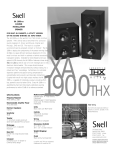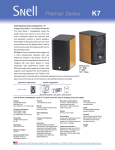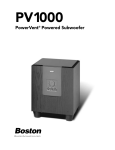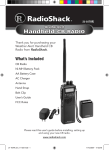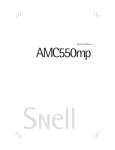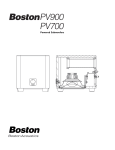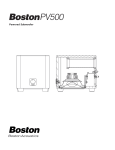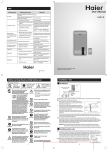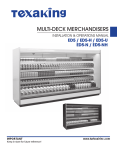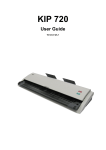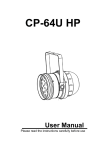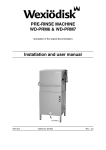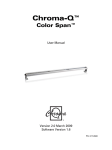Download Basis_150_Manual 454.7 KB
Transcript
Owner’s Manual Basis 150 Powered Subwoofer This symbol found on the apparatus indicates hazards arising from dangerous voltages. This symbol found on the apparatus indicates the user should read all safety statements found in the user manual. This symbol found on the apparatus indicates double insulation. WARNING! To reduce the risk of fire or electric shock, do not expose this product to rain or moisture. 1. 2. 3. 4. 5. 6. 7. 8. 9. 10. 11. 12. 13. 14. 15. 16. 17. 18. Read these instructions. Keep these instructions. Heed all warnings. Follow all instructions. Do not use this apparatus near water. Clean only with dry cloth. Do not block any ventilation openings. Install in accordance with the manufacturer’s instructions. Do not install near any heat sources such as radiators, heat registers, stoves, or other apparatus (including amplifiers) that produce heat. Do not defeat the safety purpose of the polarized or grounding-type plug. A polarized plug has two blades with one wider than the other. A grounding type plug has two blades and a third grounding prong. The wide blade or the third prong are provided for your safety. If the provided plug does not fit into your outlet, consult an electrician for replacement of the obsolete outlet. Protect the power cord from being walked on or pinched particularly at plugs, convenience receptacles, and the point where they exit from the apparatus. Only use attachments/accessories specified by the manufacturer. Unplug this apparatus during lightning storms or when unused for long periods of time. Refer all servicing to qualified service personnel. Servicing is required when the apparatus has been damaged in any way, such as power-supply cord or plug is damaged, liquid has been spilled or objects have fallen into the apparatus, the apparatus has been exposed to rain or moisture, does not operate normally, or has been dropped. Maintain a minimum distance of 50mm around the front, rear and sides of the apparatus for sufficient ventilation. The ventilation should not be impeded by covering the ventilation openings or placing on or around the apparatus items such as newspapers, table-cloths, curtains, etc. No naked flame sources, such as lighted candles, should be placed on the apparatus. The apparatus shall not be exposed to dripping or splashing. No objects filled with liquids, such as vases, shall be placed on the apparatus. Either the power inlet connector on the rear of the apparatus or the power plug at the wall must remain accessible, to be able to disconnect power from the apparatus. To completely disconnect this apparatus from the AC Mains, disconnect the power supply cord plug from the AC receptacle. Specifications Frequency Response (-3dB) 32 to 150Hz Subwoofer Amplifier Power FTC Rated Power: 150 watts @ 50Hz into 4 ohms at less than 1% THD+N Subwoofer Crossover 50–150Hz 24dB/octave low-pass LFE Input Yes Crossover Bypass Yes Bass Unit 10” (240mm) custom long-throw woofer with video-shielding Enclosure Type Bass reflex Dimensions (HxWxD) 15.75 x 13.5 x 14.25” (400 x 343 x 362mm) Weight 50 lbs (23kg) Finish Black painted walnut or Cherry veneers *In keeping with our policy of continual product improvements, specifications are subject to change without notice. Please visit our web page at www.snellacoustics.com, for the latest specifications on this product. Description The basis of any good music or cinema system is the bottom end. A subwoofer allows the main speakers to be more compact, and can be fine-tuned to individual needs. This attractive and stylish powered subwoofer will complement any stereo or home theater surround sound system with its impressive bass output and compact size. The subwoofer driver is a custom designed long-throw woofer that delivers outstanding performance that is tight and highly-musical. We video-shield the driver to allow this compact cabinet to be placed anywhere in the room. A conveniently top-mounted level control allows user adjustment without having to access to the back panel. The amplifiers have built-in variable crossovers that allow them to easily achieve a seamless blend with the main speakers, while a 24dB/octave low-pass filter prevents the subwoofers from being easily localized by ear, increasing placement flexibility. A crossover bypass function is provided for use with home theater electronics that perform their own bass management. A ruggedly built and sophisticated cabinet with real wood veneers, aluminum top cover, and sophisticated porting system allow the Basis 150 to deliver outstanding performance and aesthetics. The Snell Basis 150 is capable of impressive deep bass and high output from a remarkably compact enclosures because of the high-powered amplifier and computer-optimized tunings. Auto on-off amplifier switching and easily accessible controls make the Basis 150 as convenient to use as it is exciting to listen to. 3 Connections NOTE: Power is always supplied to the subwoofer electronics unless it is unplugged or switched to the off position using the power toggle switch located in the lower left corner of the rear panel. The auto-on circuitry only activates or deactivates the power amplifier. Make sure your subwoofer and receiver are unplugged when making the connection. Line level: Use one of the line level in jacks with most systems. These inputs accept the line level signal from your receiver’s subwoofer output. When using the crossover control input, the subwoofer’s circuitry filters out the high frequencies and sends the remaining low frequencies to the subwoofer power amplifier. Speaker level: Use these high-level terminals with receivers that do not have subwoofer output. The speaker inputs accept both left and right channel speaker signals from your receiver. NOTE: Certain receivers use speaker grounding circuits that may be incompatible with external powered audio products, such as powered subwoofers. When speaker wire is used instead of line level cables, this incompatibility can sometimes result in an audible hum when the receiver is turned off or switched to a different speaker channel. See page 8 for more information. How to Connect Using the Speaker Terminals We recommend 16-gauge wire or thicker for runs up to 15 feet (4.5m) and 14-gauge wire or thicker for longer runs. Separate the first few inches of the wire conductors. Strip off 1/2-inch (12mm) of insulation from the ends of each speaker wire to expose the two conductors and tightly twist the wire strands. WARNING: To prevent electrical shock hazard, always switch off the amplifier or receiver when making connections to the speaker. When making all connections, be sure to connect the + (red) on the speaker to the + (red) on the amplifier, and the - (black) on the speaker to the - (black) on the amplifier. IMPORTANT: Typically, one side of the wire is smooth. Connect this side to the - (black) connection. The other side has a rib or stripe. Connect this to the + (red) connection. 4 Using the five-way binding posts: The binding posts permit easy connection to banana plugs, spade lugs, and bare wire. Insert the wire in the hole (as shown on left) or a 3/8-inch spade lug over the post and tighten. For banana plugs, remove the red and black caps from the end-holes and insert either dual or single banana plugs (as shown on right). Connecting the Subwoofer to Digital Home Theater Systems Digital 5.1, 6.1 and 7.1 home theater electronics dedicate one channel (the .1) to reproduce the special low-frequency (LFE) information (such as explosions and thunder) contained in digitallyencoded sound tracks. Select subwoofer-yes from your receiver’s set-up menu. Hooked up this way, the receiver’s amplifier is relieved of having to reproduce the difficult low bass signals that can drive the receiver into audible distortion. Use an RCA cable (not included) to connect your digital receiver’s subwoofer output to the subwoofer. Connect the other end to the Basis 150 jack labeled ext crossover underneath int crossover. If you do not wish to run RCA cables to your subwoofer, you may use speaker wire to connect the subwoofer in parallel with your main speakers. The subwoofer does not present any additional load to your receiver. Select subwoofer-no from your receiver’s set-up menu. This sends the LFE signal to the main left and right speakers, and thus, to the subwoofer. Consult your receiver’s owner’s manual for more details. When using the speaker wire hookup, the subwoofer’s built-in crossover is engaged. As a starting point, set the crossover control on the subwoofer about 10Hz higher than the lower limit of your main speakers’ bass response. Fine tune the crossover setting by ear for the smoothest blend with your main speakers. The best setting of the crossover control will depend on speaker placement and personal preference. Connecting the Subwoofer to Stereo or Dolby® Pro Logic® Systems For stereo or Dolby Pro Logic systems, the easiest method is to use the same speaker wire connections as shown on page 4. You may also use the sub out connection from your receiver to the input on the subwoofer marked int crossover. When using speaker wire or the use crossover control input, the subwoofer’s built-in crossover is engaged. As a starting point, set the crossover control on the subwoofer about 10Hz higher than the lower limit of your main speakers bass response. Fine-tune the crossover setting by ear for the smoothest blend with your main speakers. The best setting of the crossover control will depend on speaker placement and personal preference. Connecting Main power switch Completely turns all power to the amplifier either on or off and over-rides the power mode switch. This switch must be turned on before setting the power mode switch (see next page). Crossover (Hz) Adjusts the frequency of the lowpass filter for the subwoofer. This control is inactive when using the ext crossover control input jack. Polarity (0 or 180) Selects regular (0°) or inverted (180°) polarity for the subwoofer. Set this switch to provide the fullest, most dynamic bass. The effect of phase will be most audible on low-frequency percussion instruments or music with a continuously repeating bass line. 5 Power indicator This two color power status light will be red when the Power Mode Switch is set to auto (without any audio signal present) and green when set to on mode. It will not light up at all until the Main Power switch is set to the on position. Power mode switch Note: The Main Power Switch needs to be in the on position before this switch is active. Auto: When set to this position, the subwoofer’s auto-on circuitry turns the amplifier on when an audio signal is presented (turning the power indicator light green), and turns it off in approximately 15 minutes if no signal is detected (turning the power indicator red). On: When set to this position, the subwoofer’s auto-on circuitry is bypassed and the amplifier will remain on whether an audio signal is present or not (the power indicator light stays green). Placement Place the subwoofer next to a wall or in a corner near your main speakers. Typically, the sound is best when the subwoofer is within 15 feet (4.5m) of the main speakers. However, the sharp 24dB/octave crossover roll-off permits placement farther from the main speakers if necessary. Since the ear is unable to localize the low frequencies of the subwoofer, the bass still appears to come from the main speakers. In most cases, the subwoofer may be placed anywhere in the listening room. The level of bass output from the subwoofer will vary at different positions in a room. When placed near walls, its loudness is emphasized. Corner placement provides the most bass output, while placement near only one wall will provide somewhat less bass. Placement completely away from walls may produce too little bass. Regardless of how you place the subwoofer, you can adjust the subwoofer’s level with its volume control. If you move the subwoofer, recheck the setting of the polarity switch. Use the setting that yields the louder and more dynamic sound. IMPORTANT: Do not place the subwoofer where there is a chance of contact between the rear panel and drapes or furniture. Avoid obstructing air flow to the back. POWER/STANDBY 6 Position subwoofer in corner for maximum bass output If Speaker Wire Connections Cause the Subwoofer to Hum Certain receivers use speaker grounding circuits that may be incompatible with external powered audio products, such as powered subwoofers. When speaker wire is used instead of line level cables, this incompatibility can result in an audible hum when the receiver is turned off or switched to a different speaker channel. If this should happen with your Snell Acoustics subwoofer, you will need to make a ground cable and connect it to either a RCA line input on the subwoofer and any unused RCA line input or output on your receiver (see diagram). The proper ground cable for this application should consist of two male RCA plugs that have their negative outside terminals (or “sleeve”) connected to each other by any length of single conductor copper cable. The inside positive (or “pin”) terminals should not be wired in either plug. If you do not wish to make your own grounding cable, please contact the Snell Acoustics Customer Service Department directly (see next page) and we will promptly ship one to you of suitable length at no charge. single conductor (-) RCA to (-) RCA ground cable use either RCA jack use any available RCA jack Back of Subwoofer Back of Receiver If Service Seems Necessary Contact the dealer from whom you purchased the speaker system. If that is not possible, call us at 978-538-6262, or write to: Snell Acoustics 300 Jubilee Drive Peabody, MA 01960 Or visit our web site at: www.snellacoustics.com Or email us at: [email protected] We will promptly advise you of what action to take. If it is necessary to return your unit to the factory, please ship it prepaid. After it has been repaired, we will return it freight prepaid in the U.S. and Canada. LIMITED WARRANTY For one year from the date of purchase, Snell Acoustics will repair for the original owner any defect in materials or workmanship that occurs in normal use of the subwoofer, without charge for parts and labor. Your responsibilities are to use the system according to the instructions supplied, to provide safe and secure transportation to an authorized Snell Acoustics service representative, and to present proof of purchase in the form of your sales slip when requesting service. Excluded from this warranty is damage that results from abuse, misuse, improper installation, accidents, shipping, or repairs/modifications by anyone other than an authorized Snell Acoustics service representative. This warranty is limited to the Snell Acoustics product and does not cover damage to any associated equipment. This warranty does not cover the cost of removal or reinstallation. This warranty is void if the serial number has been removed or defaced. This warranty gives you specific legal rights, and you may also have other rights which vary from state to state. ©2006 Snell Acoustics. All Rights Reserved. Specifications are subject to change without notice. Covered by patents issued and/or pending. Part #542-1034 300 Jubilee Drive Peabody, MA 01960 phone:978-538-6262 fax: 978-538-6266 email: [email protected] www.snellacoustics.com








